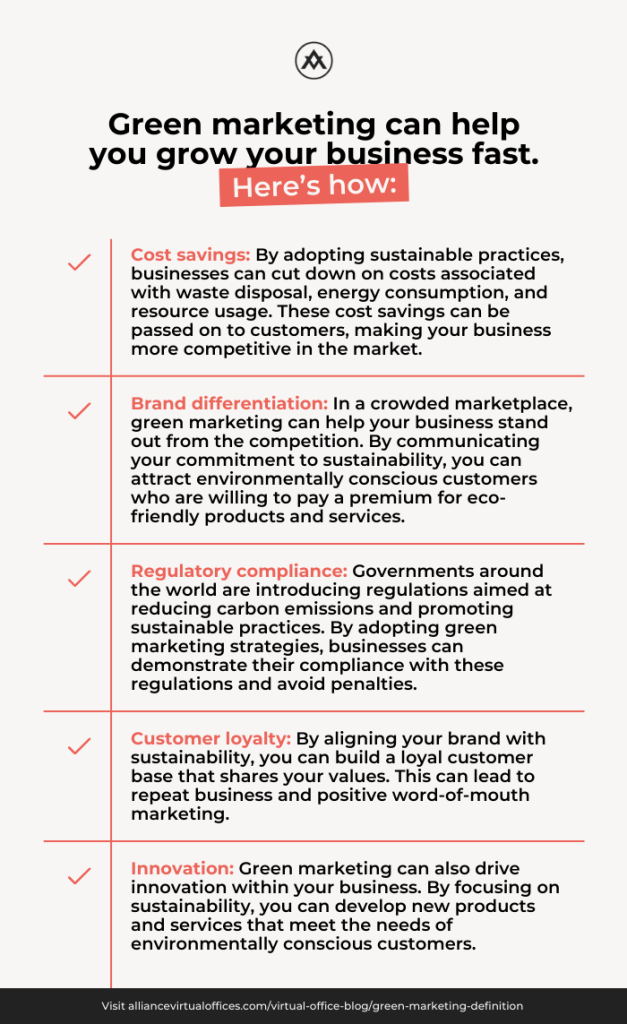- Origins and Milestones of Green Marketing
- Green Marketing for Sustainability and Profitability
- Opportunities in Green Marketing for Future Growth
Q: What is the definition of green marketing?
A: Green marketing is a strategy where a business uses its commitment to sustainability as part of its appeal to consumers. This article explores why green marketing works, who it works for, and how you can use it for your business.
In an era where environmental responsibility has become a cornerstone of consumer expectations, green marketing is transforming how businesses engage with their markets.
This strategic approach is not just about promoting eco-friendly products; it’s about integrating sustainability into the core of business operations, thereby resonating with the growing demographic of eco-conscious consumers.
In this article, we navigate the intricate landscape of green marketing, from its foundational principles to its significant impact on the business world.
Here’s why adopting green marketing strategies is a great move for small businesses.
Green Marketing Unveiled
Green marketing is a term that has been around for quite some time and has gained immense popularity in recent years. It refers to the process of promoting products or services that are environmentally friendly and sustainable.
The goal of green marketing is to positively impact the environment while simultaneously increasing businesses’ profits.
Green marketing is not just about promoting eco-friendly products or services; it is also about educating consumers about the importance of sustainability and environmental conservation.
By doing so, businesses can create a loyal customer base that values sustainability and is willing to pay a premium for eco-friendly products and services.
One key aspect of green marketing is transparency. Businesses must be transparent about their environmental impact and the steps they are taking to reduce it.
This can be achieved through eco-labeling, which provides consumers with information about the environmental impact of a product or service. By being transparent, businesses can build trust with consumers and create a positive reputation for themselves.
Green marketing is an important aspect of modern-day business. It not only promotes sustainability and environmental conservation but also helps businesses increase profits by creating a loyal customer base.
Be transparent and educate consumers. This will help your business create a positive impact on the environment while simultaneously growing.
Origins and Milestones of Green Marketing
Green marketing has been around for several decades, but it wasn’t until the 1990s that it gained significant attention. Here are some of the key milestones in the history of green marketing:
- 1970s: The first Earth Day was celebrated in 1970, which helped to increase public awareness of environmental issues. This led to the creation of the Environmental Protection Agency (EPA) in the same year, which helped to regulate pollution and other environmental issues.
- 1980s: During the 1980s, green marketing began to gain traction as companies started to realize that they could differentiate themselves from their competitors by promoting their environmental credentials. This led to the creation of the first eco-labels, such as the Blue Angel in Germany and the Nordic Swan in Scandinavia.
- 1990s: In the 1990s, green marketing became mainstream as companies began to incorporate environmental concerns into their marketing strategies. This was driven by many factors, including increased public awareness of environmental issues, the rise of the green consumer, and the growing importance of corporate social responsibility (CSR).
- 2000s: During the 2000s, green marketing continued to evolve as companies began to focus more on sustainability and the circular economy. This led to the creation of new eco-labels, such as the Cradle to Cradle certification, which evaluates products based on their environmental impact throughout their lifecycle.
- 2010s: In the 2010s, green marketing became even more important as companies began to realize that sustainability was not just a marketing issue, but a business imperative. This led to the creation of new business models, such as the sharing economy, which focused on reducing waste and maximizing resource efficiency.
The history of green marketing shows that it has evolved significantly over the past few decades, driven by a range of factors including changing consumer attitudes, regulatory pressures, and the need for businesses to operate more sustainably.
Core Principles and Strategies of Green Marketing
When it comes to green marketing, there are several core principles and strategies that businesses can use to effectively promote their eco-friendly products and services. Here are some of the key principles and strategies to keep in mind:
- Transparency and Authenticity: One of the most important principles of green marketing is being transparent and authentic about your company’s environmental practices. This means being honest about your products, production processes, and any environmental certifications or awards you have received.
- Educate Your Customers: Another key strategy is to educate your customers about the environmental benefits of your products or services. This can help build trust and loyalty and encourage customers to make more sustainable choices.
- Reduce Your Environmental Impact: Of course, the most effective way to promote green products is to actually reduce your environmental impact. This can involve everything from using sustainable materials and production processes to reducing waste and energy consumption.
- Highlight the Benefits: When promoting your green products, it’s important to highlight the benefits that customers will enjoy. This might include cost savings, improved health and wellbeing, or simply feeling good about making a positive environmental impact.
- Collaborate with Other Green Businesses: Finally, consider collaborating with other green businesses in your industry. This can help you build a stronger network, share best practices, and promote a more sustainable future for everyone.
By keeping these principles and strategies in mind, you can effectively promote your eco-friendly products and services and build a strong reputation as a socially responsible business.
Evaluating the Impact: Case Studies in Green Marketing
When it comes to green marketing, it’s essential to evaluate the impact of your efforts. Here are a few case studies that showcase the effectiveness of green marketing:
- Patagonia – This outdoor clothing company has been a leader in sustainability for years. Their “Don’t Buy This Jacket” campaign encouraged customers to think twice before making a purchase and highlighted the importance of reducing consumption. As a result, Patagonia saw a 30% increase in sales.
- Seventh Generation – This household cleaning products company has always been committed to sustainability. In 2010, they launched a campaign called “Show the World What’s Inside” to raise awareness about the chemicals in cleaning products. The campaign was a huge success, and Seventh Generation saw a 30% increase in sales.
- Toyota – The Prius is one of the most well-known green products on the market. Toyota’s marketing campaign for the Prius highlighted the car’s fuel efficiency and environmental benefits. As a result, the Prius became the best-selling hybrid car in the world.
These case studies demonstrate the power of green marketing. By highlighting the environmental benefits of your products or services, you can increase sales and build a loyal customer base. However, it’s important to be authentic and transparent in your messaging.
Customers can see through greenwashing and will only support companies that are truly committed to sustainability.
Consumer Expectations and Market Dynamics
As a consumer, you expect companies to take responsibility for their impact on the environment. This includes the products they produce, how they produce them, and the way they market them.
Green marketing is a way for companies to meet these expectations by promoting their environmentally friendly practices and products.
However, the success of green marketing depends on market dynamics.
Consumers are becoming more environmentally conscious, but they also have other priorities, such as price and convenience. Companies must balance these factors when developing their green marketing strategies.
To effectively communicate their green initiatives, companies must use clear and concise language that highlights the environmental benefits of their products.
This can be done through labeling, advertising, and other marketing materials. Companies must also be transparent about their environmental practices and provide evidence to support their claims.
The success of green marketing depends on companies meeting consumer expectations while navigating market dynamics. By effectively communicating their environmental initiatives, companies can attract environmentally conscious consumers and differentiate themselves from their competitors.
The Competitive Edge: Green Marketing and Brand Image
When it comes to marketing, few things are as important as your brand image. Consumers want to do business with companies that align with their values and beliefs, and that includes a commitment to sustainability.
By incorporating green marketing strategies into your overall brand image, you can gain a competitive edge in today’s marketplace.
One way to do this is by highlighting your company’s environmental efforts.
This could include using eco-friendly materials in your products, reducing your carbon footprint, or implementing recycling programs. By showcasing these efforts, you can demonstrate to consumers that you are committed to reducing your impact on the environment.
Another way to incorporate green marketing into your brand image is by partnering with environmental organizations.
By working with groups that share your commitment to sustainability, you can show consumers that you are part of a larger movement to protect the planet. This can help to build trust and credibility with your target audience.
Finally, consider using green messaging in your marketing materials. This could include using eco-friendly language, such as “sustainable,” “recyclable,” or “renewable,” as you can appeal to consumers who are looking for environmentally responsible products and services.
Incorporating green marketing strategies into your brand image allows you to gain a competitive edge in today’s marketplace.
Green Marketing for Sustainability and Profitability
If you’re looking for ways to make your business more sustainable and profitable, green marketing is a great place to start. Green marketing is the practice of promoting products or services based on their environmental benefits.
One of the key benefits of green marketing is that it can help you stand out from your competitors. With more and more consumers looking for eco-friendly options, businesses that prioritize sustainability are becoming increasingly popular.
By promoting your green initiatives, you can differentiate your brand and attract environmentally conscious consumers.
Another advantage of green marketing is that it can help you reduce your environmental impact. By promoting products or services that are more sustainable, you can encourage consumers to make more eco-friendly choices.
This can help you reduce your carbon footprint and contribute to a healthier planet.
To be successful with green marketing, it’s important to be transparent about your environmental initiatives. Consumers are becoming increasingly savvy and are looking for businesses that are truly committed to sustainability.
Green marketing is a powerful tool for businesses looking to improve their sustainability and profitability. By promoting eco-friendly products or services, you can differentiate your brand, reduce your environmental impact, and attract environmentally conscious consumers.
With the right approach, green marketing can help you build a more sustainable and successful business.
Technological Innovations Shaping Green Marketing
As technology advances, businesses have more opportunities to implement sustainable practices and communicate their eco-friendly efforts to consumers. Here are some technological innovations that are shaping green marketing:
- Smart Grids: Smart grids enable businesses to monitor and optimize their energy usage, reducing their carbon footprint and saving money on energy bills. This technology can also provide customers with real-time information on their energy usage, empowering them to make more sustainable choices.
- Renewable Energy: The use of renewable energy sources such as solar and wind power is becoming more widespread, allowing businesses to reduce their reliance on fossil fuels and decrease their environmental impact. Many companies are also investing in energy storage solutions to ensure a constant supply of clean energy.
- Green Data Centers: Data centers consume a significant amount of energy, but advancements in technology have allowed for the development of more energy-efficient and environmentally-friendly data centers. These centers use renewable energy sources and employ cooling techniques that reduce energy consumption.
- Internet of Things (IoT): IoT devices can be used to monitor and optimize energy usage, reducing waste and promoting sustainability. For example, smart thermostats can learn your schedule and adjust the temperature accordingly, while smart lighting systems can automatically turn off lights in unoccupied rooms.
- Virtual and Augmented Reality: Virtual and augmented reality technologies can be used to create immersive experiences that promote sustainability and eco-friendliness. For example, virtual reality tours of renewable energy facilities can educate consumers on the benefits of clean energy.
The Challenges of Embracing Green Marketing
Embracing green marketing can be a challenging task for businesses. Here are some of the challenges you may face:
- Higher costs: Implementing environmentally friendly practices can come with a higher cost compared to traditional methods. This can be a barrier for small businesses with limited resources.
- Lack of consumer awareness: While there is a growing interest in eco-friendly products, not all consumers are willing to pay extra for them. This can make it difficult for businesses to justify investing in green marketing.
- Greenwashing accusations: Greenwashing is the practice of making false or exaggerated environmental claims for marketing purposes. It can damage a business’s reputation and lead to legal consequences. Therefore, it is important to ensure that all claims made in green marketing campaigns are accurate and can be substantiated.
- Limited availability of green products: Some industries may not have many eco-friendly options, making it difficult for businesses to offer green alternatives to their customers.
Despite these challenges, embracing green marketing can have many benefits, such as increased customer loyalty, improved brand reputation, and a positive impact on the environment.
Being transparent and authentic in your green marketing efforts can help you overcome these challenges and reap the rewards.
Opportunities in Green Marketing for Future Growth
As the world becomes more environmentally conscious, green marketing presents a significant opportunity for businesses to expand their customer base and improve their brand image. Here are some opportunities in green marketing for future growth:
In conclusion, green marketing presents a significant opportunity for businesses to grow and improve their brand image.
Sustainable Practices: Beyond Marketing
Sustainable practices are more than just a marketing strategy. They are a commitment to preserving the environment and ensuring the wellbeing of future generations. Companies that adopt sustainable practices not only reduce their environmental impact but also improve their reputation and create a positive impact on society.
Here are some sustainable practices that go beyond marketing:
- Reducing waste: Companies can reduce waste by using eco-friendly packaging, recycling materials, and reducing the use of single-use plastics. Using email marketing is a particularly effective way to reduce waste while boosting the effectiveness of your campaigns.
- Using renewable energy: Companies can switch to renewable energy sources such as solar or wind power to reduce their carbon footprint.
- Sourcing responsibly: Companies can source materials from suppliers that follow ethical and sustainable practices, such as fair trade and organic farming.
- Supporting local communities: Companies can support local communities by sourcing materials locally and creating job opportunities in the area.
- Investing in research and development: Companies can invest in research and development to create innovative products and processes that are more sustainable.
It’s important to remember that sustainable practices are not just a marketing strategy but a long-term commitment to creating a better future for everyone.
Looking Ahead: The Future Landscape of Green Business Practices
As consumers become more environmentally conscious, businesses must adapt to meet their demands. Green marketing has become increasingly important, and it’s only going to become more prevalent in the future. Here are a few trends to keep an eye on:
- Sustainability as a core value: In the future, companies won’t just pay lip service to sustainability. It will be a core value that informs everything they do, from product design to supply chain management.
- Transparency: Consumers want to know where their products come from and how they were made. In the future, companies that are transparent about their environmental impact will have a competitive edge.
- Circular economy: The linear “take, make, dispose” model is unsustainable. In the future, more companies will adopt a circular economy approach, where waste is minimized and resources are kept in use for as long as possible.
- Innovation: The future of green business practices will require innovation. Companies that can find new ways to reduce their environmental impact will have a competitive edge.
- Collaboration: No single company can solve the environmental challenges we face. In the future, more companies will collaborate with each other, as well as with governments and NGOs, to find solutions.
As green marketing becomes more important, companies that don’t prioritize sustainability will be left behind. By embracing these trends, businesses can not only meet consumer demands but also help create a more sustainable future for everyone.
Wrapping Up: Green Marketing Definition
As we’ve explored throughout this article, green marketing is more than a trend—it’s a pivotal shift in how businesses operate, innovate, and communicate their commitment to sustainability.
As they embrace green marketing, companies are not only contributing to a healthier planet but are also positioning themselves as leaders in a rapidly evolving business landscape.
Further Reading:
- Green Business Ideas for Eco-minded Solopreneurs | Sustainable Business Ideas and Trends
- Blueprint to Success: Crafting Your Comprehensive Business Plan
- Forwarding Calls: A Comprehensive Guide to Call Routing and Management
- The Customer Connection: Is a Live Receptionist Your Key to Success?
For businesses looking to embark on this green journey, Alliance Virtual Offices offers a suite of eco-friendly virtual office solutions that align with your sustainability goals.
From reducing your carbon footprint to enhancing your brand’s green credentials, switching to remote work with a Virtual Office can support your green marketing initiatives.



